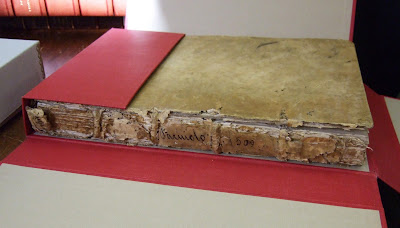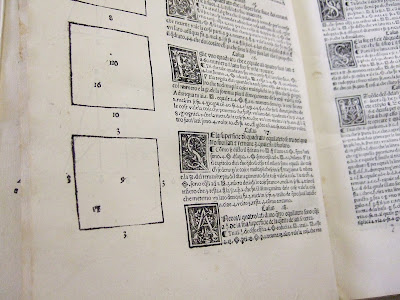 |
| From February 2011 |
About the Archivist
Allow me to introduce you to the very kind Adam Winger, Head of Special Collections & Digital Initiatives Librarian at the S.C. Williams Library at Stevens Institute of Technology in Hoboken, N.J. He’s standing amidst selected books from the personal library of the Stevens family. Adam has been with the Institute since April 2010, and has had his hands full with all manner of archival and conservation challenges, to put it mildly.
I first came in contact with Adam last fall after reading about his work in an article he published in the September/October issue of Archival Outlook. Amazed by his treasure hunt of a job, I was inspired to write him what amounts to a fan email and an offer of help. Lots and lots of snow later, I finally had the opportunity to see for myself the monumental work he has done and the huge task he faces to whip a pretty sizable and diverse collection into shape.
[Just as an aside, it seems that the more I visit archival collections, the more I see archivists putting in an enormous effort to clean up, sort out, describe, and preserve collections that were managed by well-meaning folks without archival or preservation training. For instance, Adam’s work could easily fill 3 full-time archivist positions, but he’s doing it with 1 full-time assistant curator and some part-time student workers due to lack of funding. Because institutions like Stevens are the guardians of our cultural heritage, they deserve the funding to care for their holdings in the way they should be preserved. It’s not a lot to ask, frankly.]
One of Adam’s biggest challenges is not having finding aids (very handy, descriptive documents that serve as a guide to a given collection, stating its contents and historical importance) for any of the collections. As a result, it’s difficult to tell where one collection ends and another begins. More importantly, there are many mysteries as to provenance that remain unsolved (for now).
Adam has a very strong background in conservation, having worked as a conservator at Utah State University. He also holds an MLS from the University of North Texas. Consequently, he sees areas of improvement in multiple dimensions. When he showed me some of the “before” photos, I couldn’t help catching my breath more than a few times. I can only imagine how he felt when he discovered these incredibly important historical items stored in damaging ways.
He mentioned that he’d like to do some conservation work on a 1509 work of Luca Paciolo's called De Divina Proportione. It’s a remarkable work on the golden ratio, featuring beautiful woodcuts by none other than Leonardo da Vinci. Adam said he could easily spend 150 hours working on the book. See why below.
 |
| From February 2011 |
 |
| From February 2011 |
 |
| From February 2011 |
 |
| From February 2011 |
(My apologies for the poor quality of this one.)
 |
| From February 2011 |
We all become archivists and conservators for our own reasons, but Adam’s is particularly interesting. He says, “I wanted to become an archivist after I read about the Mormon forger Mark Hofmann. I studied his methods for forgery, which led me into conservation and eventually into Special Collections.” If you’re interested, here’s an article from The New York Times that summarizes Hofmann’s criminal history.
At the moment, Adam is processing the Taylor manuscript collection, preparing about 20 digital collections, processing the university archives (a full-time job unto itself), and juggling many other projects. He says, “My favorite collection is the cuneiform clay tablets that date from around 2500 B.C.E. They are the oldest items in the collection materials, and I am fascinated with the writing system employed. I also really enjoy our da Vinciana 16th century books. They are beautifully printed. We also have a large collection of mechanical models which pose an interesting challenge to identify. I enjoy the mechanical models because of the research involved in describing them accurately.” Visitors to the Williams Library can see many of the mechanical models displayed throughout the building, especially in the main reading room. And, lucky visitors to the library will be able to see the cuneiform tablets in an exhibit in the near future.
Here are a few photos of those amazing cuneiform clay tablets. I couldn’t believe I actually held them in my (gloved) hands! (That's Adam's hand in the photo, though.).
 |
| From February 2011 |
 |
| From February 2011 |
 |
| From February 2011 |
Among other items, you can see several mechanical models standing on top of some file cabinets in the Special Collections room.
 |
| From February 2011 |
About the Archives/Special Collections
While it’s unclear exactly when the archives were established, Adam has found references to them as early as 1919. It’s also a bit difficult to tell exactly how large the holdings are at the moment because not only are they in the process of being organized as a whole, but “they extend beyond the boundaries of the library,” says Adam.
“We have 1 dedicated archive room and 3 exhibit rooms that contain artwork and objects. The library collections also are exhibited in several houses and educational building across campus,” he continues, “I am in the process of trying to locate all of the materials belonging to the library.” The day I visited Adam, he received a delivery of furniture from the President’s mansion for storage in the library because the Institute no longer has a museum. All told, the holdings include objects, artwork, manuscripts, rare books, printed materials, maps, audio materials, and visual materials.
Here's a wee video of Adam showing me some of the records and the way they used to be stored.
One of the exhibit rooms is the Mary Stuart Stevens Room (shown below).
 |
| From February 2011 |
Another exhibit room used as a reading room for the archives is the Taylor room (shown below).
 |
| From February 2011 |
 |
| From February 2011 |
Finally, there’s the da Vinci room, home to a huge facsimile collection of his works.
 |
| From February 2011 |
It holds cabinets full of da Vinci reference materials for researchers.
 |
| From February 2011 |
Visitors to the archives number 3 to 4 per week, although there are no long-term researchers there now. Adam says, “We are digitizing a large portion of our collection as well as working to provide better finding aids. So, we anticipate research use to steadily increase.” The most widely used collections are the Stevens Family and F.W. Taylor collections. “The Institute collection has a lot of draw” for those in the local community, he says.
Some of the underutilized gems of the collection include the da Vinci collection and the manuscript collections. “We have to do a better job of getting the word out about our collections so they can be used by researchers and in the classroom,” he says.
Most archives have formal collecting policies describing the boundaries of the materials and areas in which they accept donations and actively collect. However, these archives don’t. Although the policy hasn’t been written, “we do collect areas of the Stevens family, Stevens Institute, F.W. Taylor, and Leonardo da Vinci,” Adam says. Donors with small personal collections in those areas are welcomed. “We also have accepted several paintings from the Ben Wilson Foundation this past year. The estimated value of the donation was $20,000,” he says.
One trend that has become ever more important lately with funds drying up everywhere is inter-institution collaboration. Stevens has teamed with the Hoboken Public Library and Historical Society in the past. I connected Adam with a friend of mine (remember Teresa?) who works on the Rutgers end of The New Jersey Digital Highway collaboration. This way, he can get their incredible maps digitized and online much sooner (and much less expensively) than he originally thought he would.
Speaking of digitization, Adam plans to go live with his digitized collections in the spring. I’ll post the link when the content has been added and visitors have great items to explore. He is working toward creating finding aids for researchers and making the collections searchable online in the near future.
Contact information
Interested users and donors should contact
Adam Winger
Head of Special Collections &
Digital Initiatives Librarian
S.C. Williams Library
Stevens Institute of Technology,
Hoboken, NJ
http://www.stevens.edu/library
awinger(at)stevens.edu
201-216-5416
For updates to the archives and Special Collections, see the blog here: http://stevenslibrary.blogspot.com/.